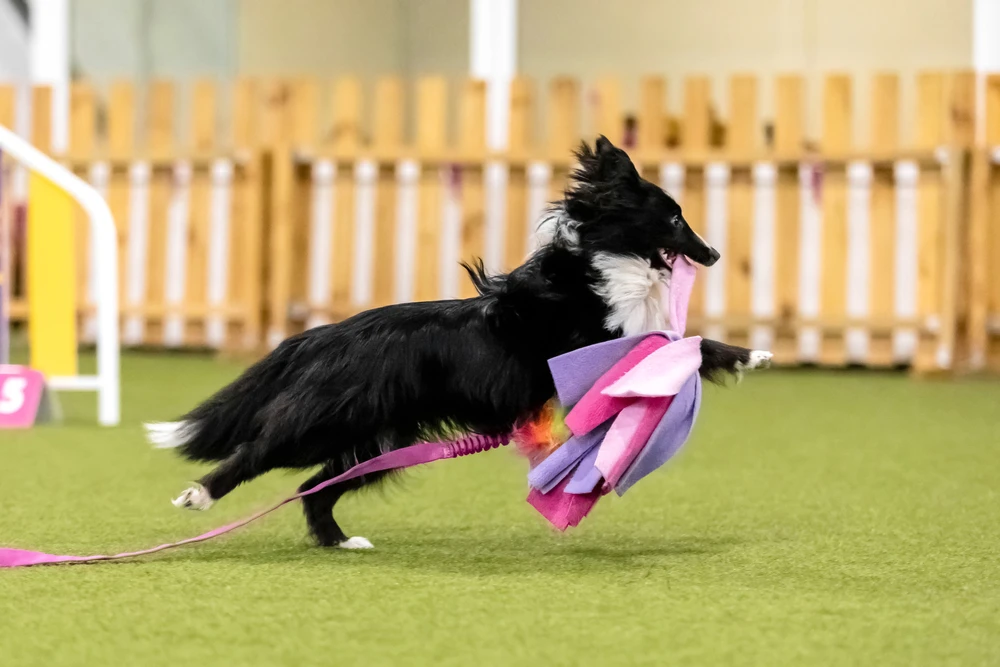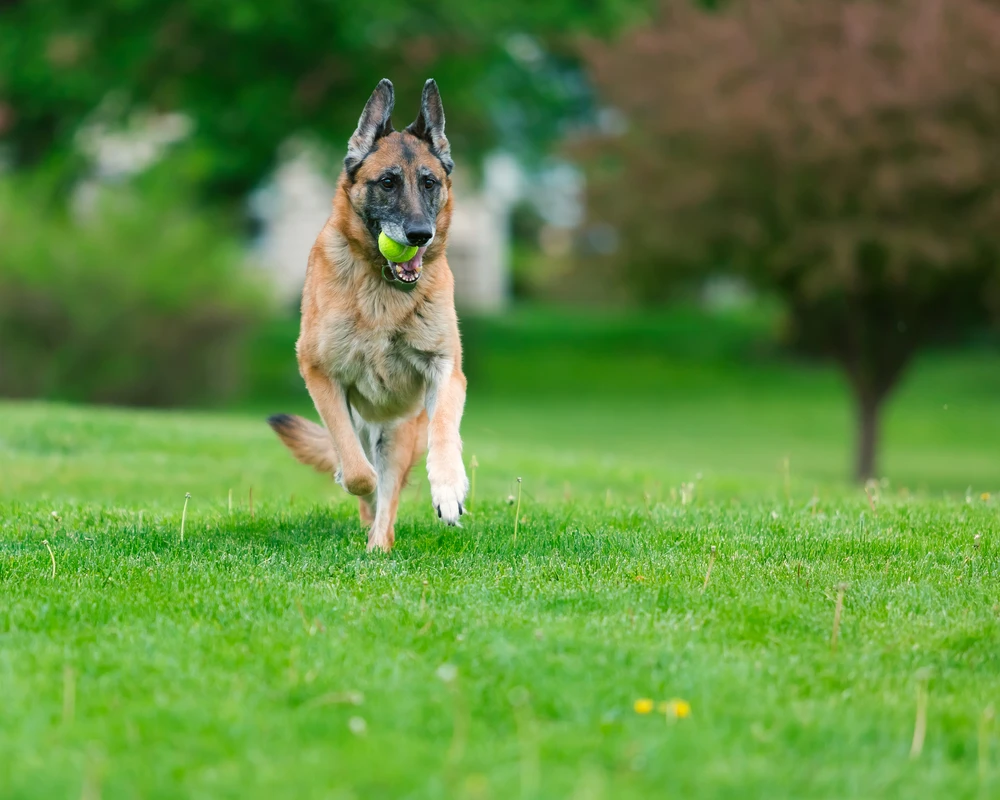
As a dog lover, you’ve probably wondered what could make agility training engaging to your pet. Does it keep all canines mentally and physically challenged, or is it only effective with certain breeds?
Acclaimed dog trainer Cesar Millan has inspired pet parents around the world to go beyond the daily dog walk and start agility training. His philosophy states that dog owners should establish themselves as calm, assertive pack leaders and fulfill their pet’s three primary needs to keep them happy and confident.
Keep reading to discover why having an agility dog is good for you and them, learn what happens in agility classes and learn about Cesar Millan’s three needs for dogs and his approach to being a dog owner.
The Basics of Agility Training
Taking part in agility trials is an exhilarating, fun activity for dogs. This thrilling sport involves navigating agility obstacles in a timed obstacle course, tackling weave poles, tunnels, jump bars and contact obstacles, such as the dog walk and A-frame. It’s a perfect combination of mental stimulation and physical exercise for dogs, making it ideal for most dogs, including mixed breeds, pedigreed dogs and large and small dogs.
At an entry-level agility event, your dog needs to know basic obedience commands to make sure it’s ready to begin agility training. As its agility improves, it can progress to a more complicated agility class with more rules to follow and obstacles that are harder to navigate. Providing access to activities that build on your pet’s innate talents — speed and dexterity — fulfills its primal need to work hard and improve physically and mentally. Nothing takes care of a dog’s energy like an agility course.
Benefits of Agility Training for Dogs
When it comes to dogs, agility comes naturally. Trying out an agility trial is a great way to bond with your dog and help it be as happy, confident and obedient as possible. Below you’ll learn about the many benefits of an agility program for you and your dog.
Physical Benefits
As every dog owner knows, active dogs are happy dogs. If you don’t go on plenty of dog walks and seek out social interaction at the dog park, there’s a good chance your furniture will suffer, and your neighbors will hear about it. Adding dog sports to your weekly roster of pet playtime is one of the best ways to encourage good behavior, improve endurance, manage weight and help dogs learn body awareness.
Let’s explore the physical advantages of dog agility training in more detail:
- Improved endurance: Agility trials are fast-paced and rigorous, motivating dogs to use as much energy as possible and push harder for rewards. Sustaining the energy to run, weave, jump and climb improves your dog’s heart health, building stamina and improving endurance. It’s a true pleasure to see your dog progress through agility courses and improve its performance with every session.
- Weight management: Despite their best intentions, many dog owners overfeed their pets — mainly because it’s so hard to resist those puppy-dog eyes. However, obesity can cause health issues and reduce a dog’s life span. Dog agility classes present the perfect opportunity for weight management, providing intense dog exercise and burning off the calories from the treats they get while taking part in the sport.
- Enhanced coordination and flexibility: Agility training lets dogs take part in a wide range of obstacles, including the down ramp, tire jump and pause table. They traverse moving objects in a predetermined pattern and navigate contact zones, developing better coordination and flexibility along the way. Over time, your dog’s flexibility and joint health can improve, slowing the effects of aging and ensuring it remains as healthy as possible.
Mental Benefits
It’s pretty obvious that dogs love being physically challenged, but you might not realize that mental stimulation is just as crucial to their well-being. Boredom is one of the most common causes of unwanted behavior in dogs, and an agility course is an excellent cure.
After you start agility training, your dog will enjoy the following mental benefits:
- Increased intelligence and problem-solving abilities: Your dog relies on its senses to solve problems, and agility training stimulates its hearing, smell, sight and touch. The sport encourages dogs to quickly assess their surroundings and determine the best route to tackling obstacles. As your dog gains experience, it will be able to anticipate the handler’s cues and gain a sharper response to voice commands.
- Enhanced focus and concentration: With their razor-sharp senses, dogs can be easily distracted, which makes basic obedience harder and is frustrating for you and your pet. Agility dogs are more focused because they’re consistently rewarded for paying attention and reacting as quickly as possible. Those rewards reinforce focus and responsiveness in and outside the agility class — whether you’ve got an active puppy or a calm older dog.
- Building of confidence and trust: Dogs are confident when they know what’s expected from them and feel like they’re getting it right. Just like people, mastering a new skill makes a dog feel proud and accomplished, and it influences its behavior in a wide range of contexts. What’s more, agility training fosters a deep sense of trust between you and your pet as you learn to navigate dog obstacle courses as a team. Your dog will come to rely on you as a trusted source of guidance, similar to how its primal ancestor would have developed trust and adoration for its pack leader.
Social Benefits
Dog agility training presents owners with a perfect chance to bond deeply with their pets. It also gets dogs accustomed to concentrating when there are other dogs around. Let’s delve deeper:
- Strengthened owner-dog bond: During agility sessions, you and your dog work as a team. How well you communicate together determines how well the course goes — and you’ll see improvements with every session. Cooperating as you work toward a common goal strengthens your bond as your dog grows to see you as its competent, strong pack leader. As it learns to rely on you for the type of support it expects from a leader, it’ll become more responsive to your commands and cues.
- Socialization with other dogs: Agility classes are a social environment, exposing your pet to a range of dogs and helping it be more confident and comfortable around unfamiliar pets. That means there’ll be less excitement and pulling on the leash every time another dog approaches while you’re out on a walk. It also means it’ll be more responsive to commands, even if it’s distracted by an oncoming dog wagging its tail.

How Dog Agility Training Aligns With Cesar Millan’s Techniques
Cesar Millan is an internationally celebrated dog behaviorist whose ideas have resonated with and helped many pet owners and their dogs. His core belief is that dogs have three primary needs — exercise, discipline and affection — and in that order. He states that dog owners should act as calm, assertive leaders, reflecting the pack system dogs have descended from. By focusing on fulfilling those three basic needs, you create a balanced relationship that’s aligned with your dog’s instincts, promoting good behavior and well-being.
Agility training for dogs complements Cesar’s philosophy by providing exercise, teaching discipline and offering affection in return for good behavior. As you progress through training, your dog continually gets positive reinforcement for improving its fitness and understanding of boundaries. As a result, you build a stronger, more loving bond as you establish your place in Millan’s hierarchy.
Taking Millan’s approach into consideration as you and your pet enjoy agility classes together can enhance your experience and ensure you get the most out of sessions. As Millan states, providing dogs with varied opportunities to meet their basic needs is the best way to raise and nurture a well-adjusted, fulfilled and well-behaved dog.
Getting Started With Agility Training
Do you want to turn your pet into an agility dog? Getting started with this thrilling adventure is easier than you might think. Start agility training by making sure your dog has mastered basic obedience commands. You can even set up some homemade obstacles in the backyard to establish a solid foundation for formal classes.
Before your dog’s first lesson, be sure to do plenty of research into which elements of agility it’ll excel in so you can tailor its experience based on its strengths and weaknesses. While it’s good to encourage your pet to improve skills, it doesn’t excel in, focusing too much on those can impact its motivation.
Explore local clubs, and check out tools and equipment that can enhance the agility experience for your pet. One great example is the Halo Collar, which has GPS tracking, remote training capabilities and virtual fencing to improve safety and control during sessions.
Safety Considerations in Agility Training
Agility courses provide your dog with endless fun, but they come with crucial safety considerations. Always prioritize your pet’s well-being by following recommended best practices and using proper equipment. That starts with a thorough warm-up to loosen your dog’s muscles and prevent injury and gradually introduce new obstacles instead of overwhelming it with too many new experiences too quickly.
Be sure to take plenty of water breaks, and ensure your dog is properly fed before attending class. Consider options such as using the Halo Collar, which offers GPS tracking and enhances safety controls. Although class leaders take steps to maintain a safe environment, dogs are animals and can run away suddenly. A Halo Collar gives you peace of mind so you can stay fully focused and present during sessions.
Unleash Your Dog’s Potential With Agility Training Today
In this article, you’ve learned about the variety of benefits agility sessions can provide your dog, including physical, mental and social stimulation. By taking part in classes with Cesar Millan’s philosophy in mind, you can improve the bond between you and your pet. Over time, you’ll be able to shape its behavior, thanks to improved response to commands, and enhance trust between dog and owner.
Embark on this exciting journey with your dog to give it something to look forward to beyond a weekly trip to the dog park or a visit from a dog friend. To ensure training is as safe as possible, consider using the innovative Halo Collar. With its remote training capabilities and safety features, you can enjoy this dog activity free from worry.






